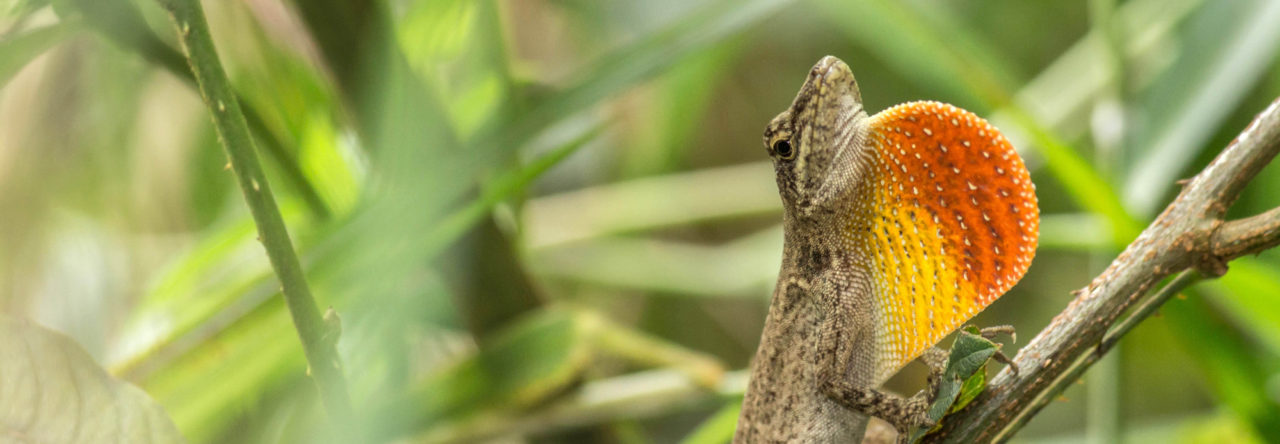
Results of mating trials in Ng et al.’s study. Top two rows are within-population crosses; bottom two are between crosses from different populations that differed in dewlap color. Note that in the top, individuals look like their fathers, whether at the bottom, dewlap colors are intermediate between that of the two populations.
Everybody loves a pretty dewlap, and recent years have seen a lot of interest in studying the factors that determine dewlap color, as well as the role dewlap color may play in species recognition, sexual selection and other processes. Many have suggested that the dewlap is a focus of sexual selection; some have even opined that it is an honest signal of something, maybe good genetic quality, maybe the ability to procure lots of color-inducing dietary items. Unfortunately, we know almost nothing about the genetic basis of dewlap color, nor about the effect of environmental variation.
Anolis distichus exhibits more variation in dewlap color and pattern than any other anole, and thus is the perfect choice for such a study. Julienne Ng just completed her doctoral research at U. Rochester on this species, documenting that variation in dewlap color correlates with environment among populations. Now she and colleagues report on laboratory studies to assess the extent to which variation is determined by genes vs. diet.
Why diet? Because reds and oranges are likely determined by carotenoids, which vertebrates cannot synthesize. Thus, it is plausible that the amount of carotenoids ingested by a lizard may correlate with its color. This hypothesis has only been tested once before, in a study on A. sagrei by Steffen, who failed to find evidence for a diet effect on the red-orange dewlap of this species.
This study had two components. First, to study genetics, lizards from two populations–one with an orange dewlap, the other with a plain whitish dewlap–were crossed in the laboratory. Second, lizards were fed lots of carotenoids.
The results: strong evidence for a genetic basis for variation in dewlap color. Purebred individuals looked like their fathers (top two rows in figure above), but crosses were intermediate in color (bottom two). Pretty strong evidence for a genetic basis for the trait. And the effect of diet? Not so much. No difference in color between lizards in the carotenoid supplementation treatment vs. the control lizards.
The bottom line is that, at least in this species, genes control variation in dewlap color. Combined with Steffen’s study, there are now two negative results for a role of diet. Of course, work on other species is necessary to confirm the generality of these results, as well as additional investigation into the exact genes responsible for dewlap color.
- Evolution in Real Time on Lizard Island - March 23, 2025
- Spider Snags Adult Anolis osa - March 22, 2025
- An Homage to the Green Anoles of New Orleans - March 21, 2025


Cybokat
Great! I love studies that support the idea that signals are not honest indicators of quality. It makes researching the meachanism behind them much more fun.
Ambika Kamath
Do these results really suggest that colour isn’t an honest indicator at all? It isn’t an indicator of the ability of a lizard to obtain carotenoids, but could still indicate genetic quality of some other kind.
Rich Glor
They definitely could still be honest signals of mate quality.
Rich Glor
Thanks for the post on Julienne’s paper. It’s also worth pointing out that our supplementation experiment and Steffen’s were conducted over relatively short intervals in adult animals. It will be interesting at some point to do these experiments with hatchlings and juveniles, and over longer periods of time.